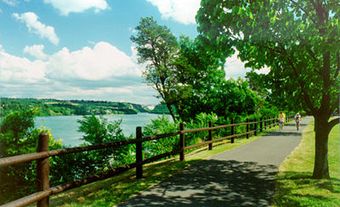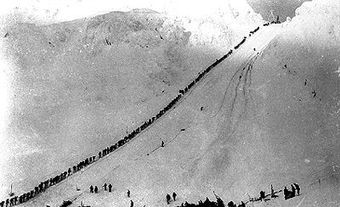White Pass, elevation 888 m, sits on the Alaska-BC boundary, approximately 125 km south of Whitehorse, YT. In 1887 the federal government sent William OGILVIE to survey the 141st meridian national boundary where it crosses the Yukon River; members of his party found the pass. It was named for Thomas White, then minister of the interior. After the KLONDIKE gold strike (1896), thousands crossed White Pass during 1897 and 1898 to reach the goldfields at DAWSON. The narrow-gauge WHITE PASS AND YUKON RAILWAY from Skagway to Whitehorse was built between 1898 and 1900. It closed in 1982, a year after the highway over the pass was officially opened.
-
- MLA 8TH EDITION
- Boles, Glen. "White Pass". The Canadian Encyclopedia, 24 January 2014, Historica Canada. www.thecanadianencyclopedia.ca/en/article/white-pass. Accessed 24 April 2024.
- Copy
-
- APA 6TH EDITION
- Boles, G. (2014). White Pass. In The Canadian Encyclopedia. Retrieved from https://www.thecanadianencyclopedia.ca/en/article/white-pass
- Copy
-
- CHICAGO 17TH EDITION
- Boles, Glen. "White Pass." The Canadian Encyclopedia. Historica Canada. Article published February 07, 2006; Last Edited January 24, 2014.
- Copy
-
- TURABIAN 8TH EDITION
- The Canadian Encyclopedia, s.v. "White Pass," by Glen Boles, Accessed April 24, 2024, https://www.thecanadianencyclopedia.ca/en/article/white-pass
- Copy
Thank you for your submission
Our team will be reviewing your submission
and get back to you with any further questions.
Thanks for contributing to The Canadian Encyclopedia.
CloseArticle
White Pass
Article by Glen Boles
Published Online February 7, 2006
Last Edited January 24, 2014
White Pass, elevation 888 m, sits on the Alaska-BC boundary, approximately 125 km south of Whitehorse, YT. In 1887 the federal government sent William OGILVIE to survey the 141st meridian national boundary where it crosses the Yukon River; members of his party found the pass.

 Share on Facebook
Share on Facebook Share on X
Share on X Share by Email
Share by Email Share on Google Classroom
Share on Google Classroom


